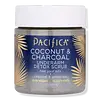What's inside
What's inside
 Key Ingredients
Key Ingredients

 Benefits
Benefits

 Concerns
Concerns

 Ingredients Side-by-side
Ingredients Side-by-side

Water
Skin ConditioningCetyl Alcohol
EmollientPrunus Armeniaca Seed Powder
AbrasiveGlycerin
HumectantGlyceryl Stearate Citrate
EmollientCharcoal Powder
AbrasiveMaranta Arundinacea Root Powder
Skin ConditioningCoco-Caprylate
EmollientHydrolyzed Verbascum Thapsus Flower
AntioxidantCocos Nucifera Oil
MaskingCamellia Sinensis Leaf Extract
AntimicrobialDecyl Glucoside
CleansingPotassium Cetyl Phosphate
EmulsifyingXanthan Gum
EmulsifyingDiheptyl Succinate
EmollientCapryloyl Glycerin/Sebacic Acid Copolymer
Skin ConditioningPhenoxyethanol
PreservativeEthylhexylglycerin
Skin ConditioningParfum
MaskingWater, Cetyl Alcohol, Prunus Armeniaca Seed Powder, Glycerin, Glyceryl Stearate Citrate, Charcoal Powder, Maranta Arundinacea Root Powder, Coco-Caprylate, Hydrolyzed Verbascum Thapsus Flower, Cocos Nucifera Oil, Camellia Sinensis Leaf Extract, Decyl Glucoside, Potassium Cetyl Phosphate, Xanthan Gum, Diheptyl Succinate, Capryloyl Glycerin/Sebacic Acid Copolymer, Phenoxyethanol, Ethylhexylglycerin, Parfum
Sucrose
HumectantGlycerin
HumectantCarthamus Tinctorius Seed Oil
MaskingParfum
MaskingGlyceryl Caprylate
EmollientButyrospermum Parkii Butter
Skin ConditioningCocos Nucifera Oil
MaskingHibiscus Sabdariffa Leaf
Skin ConditioningMangifera Indica Seed Butter
Skin ConditioningTheobroma Cacao Seed Butter
EmollientSimmondsia Chinensis Seed Oil
EmollientOlea Europaea Fruit Oil
MaskingTocopheryl Acetate
AntioxidantGlyceryl Undecylenate
EmollientSucrose, Glycerin, Carthamus Tinctorius Seed Oil, Parfum, Glyceryl Caprylate, Butyrospermum Parkii Butter, Cocos Nucifera Oil, Hibiscus Sabdariffa Leaf, Mangifera Indica Seed Butter, Theobroma Cacao Seed Butter, Simmondsia Chinensis Seed Oil, Olea Europaea Fruit Oil, Tocopheryl Acetate, Glyceryl Undecylenate
Ingredients Explained
These ingredients are found in both products.
Ingredients higher up in an ingredient list are typically present in a larger amount.
Cocos Nucifera Oil is obtained from the kernels of the coconut fruit. In other words, this is coconut oil.
Coconut Oil is rich in fatty acids with lauric acid making up the majority of these. It also contains linoleic acid. Due to this high fatty acid content, coconut oil helps trap moisture and soften skin.
Despite being antibacterial, coconut oil may not be great for acne-prone skin. It is comedogenic and may clog pores. This ingredient may not be safe for malassezia or fungal acne.
Note: Coconut Oil should not replace your sunscreen for UV protection. Studies show it only blocks about 20% of UV.
This oil is non-volatile and has a light scent.
The term 'fragrance' is not regulated in many countries. In many cases, it is up to the brand to define this term. For instance, many brands choose to label themselves as "fragrance-free" because they are not using synthetic fragrances. However, their products may still contain ingredients such as essential oils that are considered a fragrance.
Learn more about Cocos Nucifera OilGlycerin is already naturally found in your skin. It helps moisturize and protect your skin.
A study from 2016 found glycerin to be more effective as a humectant than AHAs and hyaluronic acid.
As a humectant, it helps the skin stay hydrated by pulling moisture to your skin. The low molecular weight of glycerin allows it to pull moisture into the deeper layers of your skin.
Hydrated skin improves your skin barrier; Your skin barrier helps protect against irritants and bacteria.
Glycerin has also been found to have antimicrobial and antiviral properties. Due to these properties, glycerin is often used in wound and burn treatments.
In cosmetics, glycerin is usually derived from plants such as soybean or palm. However, it can also be sourced from animals, such as tallow or animal fat.
This ingredient is organic, colorless, odorless, and non-toxic.
Glycerin is the name for this ingredient in American English. British English uses Glycerol/Glycerine.
Learn more about GlycerinParfum is a catch-all term for an ingredient or more that is used to give a scent to products.
Also called "fragrance", this ingredient can be a blend of hundreds of chemicals or plant oils. This means every product with "fragrance" or "parfum" in the ingredients list is a different mixture.
For instance, Habanolide is a proprietary trade name for a specific aroma chemical. When used as a fragrance ingredient in cosmetics, most aroma chemicals fall under the broad labeling category of “FRAGRANCE” or “PARFUM” according to EU and US regulations.
The term 'parfum' or 'fragrance' is not regulated in many countries. In many cases, it is up to the brand to define this term.
For instance, many brands choose to label themselves as "fragrance-free" because they are not using synthetic fragrances. However, their products may still contain ingredients such as essential oils that are considered a fragrance by INCI standards.
One example is Calendula flower extract. Calendula is an essential oil that still imparts a scent or 'fragrance'.
Depending on the blend, the ingredients in the mixture can cause allergies and sensitivities on the skin. Some ingredients that are known EU allergens include linalool and citronellol.
Parfum can also be used to mask or cover an unpleasant scent.
The bottom line is: not all fragrances/parfum/ingredients are created equally. If you are worried about fragrances, we recommend taking a closer look at an ingredient. And of course, we always recommend speaking with a professional.
Learn more about Parfum